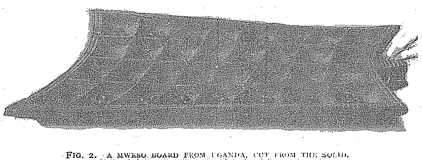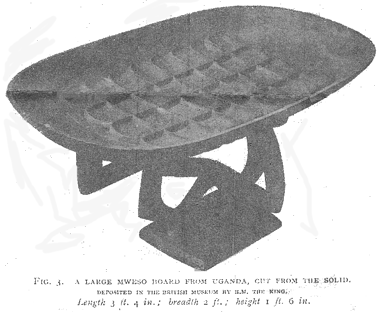Game of Mweso in Uganda
H.J. Braunholtz, British Museum
Man, Vol. XXXI, 131-158, July 1931, pages 121-124
[Note: This 1931 document was retrieved using a microfiche reader and printer sometime in the 1960s. That printer generated a sepia colored negative which was scanned to produce this Webpage. Consequently, the photographs accompanying this document are not as "sharp" as many photographs normally viewed on the Web.]
[Page 121] The following variety of the game of "Mancala" was noted by me in 1929, as played by some of the Baganda at Entebbe. The game is called mweso after the wooden board on which it is played (Plate G. 2 and 3). The board has four rows of eight holes each, two rows for each p1ayer (see diagram, fig. 4). Each player has thirty-two pieces as counters, consisting of wild banana seeds (mpiki), which are distributed evenly in the back rows, four pieces to a hole, as a preliminary formality. Before commencing play the player may re-distribute their own pieces in any way they please in their own two rows. A favorite arrangement was to gather a large number in the two holes in the back row on the player's extreme left (i.e., A7 and A8; and D1 and D2).

Moves -Each player moves in turn by picking up all the pieces from anyone of his holes containing more than one piece, and dropping one piece in each successive hole in the direction of movement, starting with the hole next to that from which he has picked up. Normal movement is from the player’s left to right along the back row (i.e. A8 to A1, and D1 to D8), and then from right to left along the front or centre row (i.e. B1 to B8, and C8 to C1), in fact, counter-clockwise, if we regard the movement of each player round his own two rows as a circular one. Single [Page 122] pieces may not be moved. Thus if player Y picks up eight pieces from hole D2, he will drop one each in holes D3, D4, D5, D6, D7, D8, C8, C7, in that order. If the last piece of those picked up fall into a hole already containing one or more pieces, the player picks up all the pieces in that hole, including the one he has just dropped into it, and again deals them out, one at a time, in successive holes in the same manner and direction as before. He repeats the process until the last piece of his "pick-up" falls into an empty hole. It is then his opponent's turn to move. Although normal movement is counter-clockwise, if a player picks up from any of the four holes on his extreme left (those marked with a cross on the diagram) he may move in the reverse direction, i.e., clockwise, if he wishes. But having started a move in one direction, he must continue in the same direction until that particular move is finished.
Capture -If a player's last piece falls in one of his front row holes which already contain one or more pieces, and if his opponent’s front and rear holes opposite to that hole both contain one or more pieces, he captures all his opponents pieces in those two holes. His move then continues, not from the hole he has just reached, but from the hole adjacent on the near side, to the one which he last emptied. Adding the captured pieces to those already in this hole, he continues his move as before with all these pieces.
For example: Y picks up five pieces from D6, and places one each in D7, D8, C8, C7, and C6. If C6 is an occupied hole and X's holes A6 and B6 are also both occupied, Y captures all the pieces in A6 and B6, adds them to the piece or pieces in D7, and picking up all the pieces now in D7, distributes them one by one in D8, C8, C7, C6, etc., as far as they will go. Should his last piece effect another capture, he must return with these newly captured pieces to D8, since D7 as well as D6 will now be empty.
Object -Theoretically, the object of the game is to capture all the opponent's pieces. But in practice this is almost impossible, and victory may also be achieved in either of the two following ways. If a player is left with not more than one piece in any of his holes; or if both holes at both ends of his two rows (i.e., the four holes marked 0 on the diagram) are all empty simultaneously, his opponent has won the game.

It will be noticed that this form of the game differs only slightly in its essential features from the Didinga and Lango varieties described by Mr. J. H. Driberg in MAN, l927, 114 and 127, and combines the Didinga method of capture with the use of the Lango “turning base" (i.e., the four holes from which one may move ether clockwise or counter-clockwise). It is, however, possible that there may be further details in the rules of the Baganda game, which were not explained by my interpreter. My time was not long to allow more than a few experimental games to be played; and it may be that certain possible contingencies have not been provided for in the rules given here. I trust that if this account comes to the notice of anyone with fuller experience than mine of the Baganda method he will supplement it as far as may be necessary.

The mweso board illustrated in Plate G.2 was kindly obtained for me by Mr. E. J. Wayland, Director of the Geological Survey of Uganda. It is cut from it single piece of wood, and has a rawhide thong attached for carrying. The complete set of 64 mpiki is seen arranged in the position as described. This is the ordinary type of board in use by the people.
Plate G.3 illustrates an unusually large and finely carved specimen, which, with its openwork stand, is cut from a single block of pale wood. It was presented to H.M. the King by H.H. Daudi Chwa, King of Uganda, and has been deposited in the British Museum since 1919.
Last update January 11, 2010
